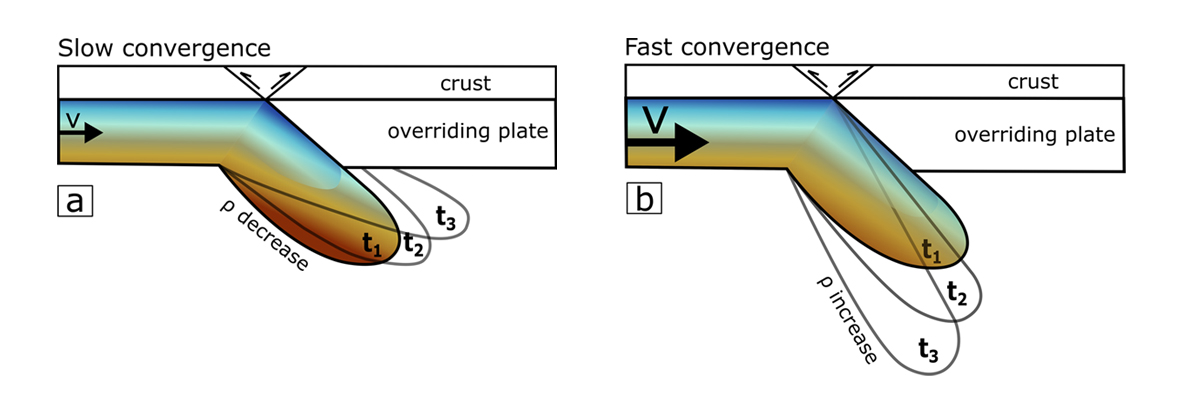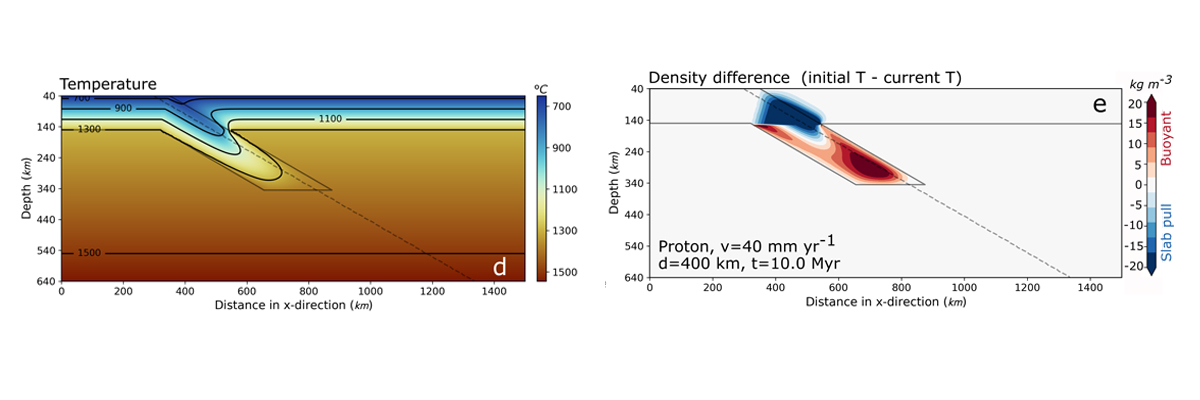
A fast collision rate between tectonic plates and a young age are two factors that favour the sinking of the lithosphere in the mantle, according to a new study made by researchers from the Institute of Earth Sciences Jaume Almera of the Spanish National Research Council (ICTJA-CSIC). The study has been published recently in the Scientific Reports journal.
The authors of the study developed a new numerical model that allows to study the effect of the convergence rate between tectonic plates and its composition on the lithospheric mantle density promoting or avoiding its sinking during the subduction or delaminating processes.
“The model designed in this study provides a methodological framework for understanding the stability of the lithosphere during the convergence of the tectonic plates”, said Kittiphon Boonma, PhD student of the SUBITOP project at ICTJA-CSIC and first author of the study.
Lithosphere is the Earth’s rigid outermost layer that comprises the crust and uppermost mantle and it forms the different tectonic plates. These plates float and displace over the asthenosphere, a denser and more viscous layer of the sublithospheric mantle. In the areas where plates converge, one of the plates sinks below the other, thrusting into the sublithospheric mantle. This would be the typical case of the oceanic lithosphere subduction zones. Another possibility is that, in continental collision zones, the lithospheric mantle of one of the plates separates from (“peels off”) the crust and sinks into the asthenosphere, in a process known as delamination. Both processes are sensitive to the lithospheric mantle density which, at the same time, depends on the pressure, temperature and chemical composition or, which is the same, of the convergence rate and the age of the lithosphere.
“Our simulations combine lithospheric composition for different plate ages with a wide spectrum of plate collision rates to understand what determines the positive or negative buoyancy of the lithosphere”, said Daniel García-Castellanos, researcher at ICTJA-CSIC and co-author of the study.
«The main advance of our work is the analysis of the dependence of lithospheric mantle buoyancy on density variations resulting from the advection-diffusion balance considering a wide range of tectonic convergence rates and different lithospheric mantle chemical compositions», said Kittiphon Boonma.
Researchers performed several simulations with the new model considering 3 different types of continental lithosphere, with an age range between 2.5 Ga and 1 Ga year, and two oceanic lithospheres aged 120 and 30 milion year old. They considered 6 different convergence rates between 1 and 80 mm/year. Simulations were aimed to observe the effect of the different collision rates and compositions on the lithospheric mantle density.
“In subduction or continental collision processes there are two opposite effects that affect the mantle density. Density increases due to pressure increases but, at the same time, it tends to decrease due to the temperature increase produced by the depth. The predominance of one of these two effects will depend on the convergence velocity. Moreover, the mantle density depends also on its own chemical composition and it has been observed that it decreases with the age”, explains Manel Fernández, co-author of the study.

The model outcomes showed that the oldest and thickest continental lithospheric mantle (Archon) was less dense than the asthenosphere and avoided the sinking. At low and moderate convergence rates, researchers found that the two other types of continental lithospheric mantle shifted from sinking to stay stables due to their thinner thicknesses and to the loss of density induced by the temperature increases due to the depth. Last, the two different types oceanic lithosphere always sank, whatever the applied convergence rate was, due to their bigger density derived from it composition.
“According to these results, the faster the convergence rate between two continents, the bigger the probability that one of them delaminates or sinks towards the mantle», explains Daniel García−Castellanos.
«Results suggest an explanation on why the young plates often sinks easily into the mantle, being recycled in the mantle while cratons (oldest continental regions) seem to resist better the changes in tectonic forces during Earth’s evolution and they are less prone to subduct or delaminate», said García-Castellanos. Ivone Jiménez-Munt and Ajay Kumar are the two other authors of this research.
Original article
Boonma, K., Kumar, A., Garcia-Castellanos, D., Jiménez-Munt, I. and M. Fernàndez. Lithospheric mantle buoyancy: the role of tectonic convergence and mantle composition. Scientific Reports 9, 17953 (2019) doi:10.1038/s41598-019-54374-w
